化合物英文命名规则
浅谈有机化合物的英文命名

浅谈有机化合物的英文命名沙文彬零陆化甲 06507003对有机化合物进行命名是有机化学工作者和学习有机化学的人经常要面对的问题,而且也是一项必需的技能。
而掌握有机物的英文命名在当今科技发展迅猛,交流日益国际化的情形下也是必须的。
尤其在查阅化学文献时,知道某一有机物的英文名显得尤为重要。
对一些简单的有机物,人们根据所学的中文命名法基本上可以得出英文名称。
如有机物1的英文名称是比较简单的:3-ethyl-2,5-dimethylheptane(2,5-二甲基-3-乙基庚烷)。
而对像有机物2一样的多官能团有机物,人们往往连如何用中文命名都不知道,更不要说用英文了。
有机物2该当做醚(ether),某酸乙酯(ethyl ester),酮(ketone),还是烯(alkene)呢,但是有机物2只有一个正确的英文命名:ethyl 3-(4-methoxy-2-oxo-3-cyclohexenyl)propanoate [3- (4-甲氧基-2-氧代-3-环己烯基)丙酸乙酯]。
OOCHCHCH33CCHOCH23CHCHCHCHCHCHCH22332CH3CHO3有机物2有机物1掌握有机物的英文命名其实并不困难。
只要有中文命名的基础,再掌握一些官能团相应的英文名称,并注意中英文命名中的差异,基本就可以了。
一个有机物的英文名称由如下四个部分构成:Locants-Prefix-Parent-Suffix。
即由编号,前缀(取代基名称),母体(主链或环的大小),后缀(该有机物从属的类别)构成。
因此确定一个有机物的英文名称的过程由两步组成:首先分别确定上述的四个部分,然后依正确的顺序和格式将它们表达出来。
下分别介绍确定四部分的方法和正确的表达方式。
后缀的确定对于单官能团有机物英文名称的后缀,只要知道英文中此官能团做后缀时所用的名称就可以了。
而当遇到多官能团有机物时,后缀的选择就有点困难了。
在命名时我们不能同时使用多个后缀,只能从此化合物所含的所有官能团中选择一个作为后缀。
有机化学---有机化合物的命名

化合物英文命名

§2.1无机化合物 (Inorganic compounds)
一、元素(Elements)
1 H hydrogen 2 Li lithium 3 Na sodium 4 K potassium 5 Rb rubidium 6 Cs cesium/caesium 7 Fr francium
❖ 34 ❖ 35 ❖ 36 ❖ 37 ❖ 38 ❖ 39 ❖ 40 ❖ 41 ❖ 42 ❖ 43 ❖ 44
F fluorine Cl chlorine Br bromine I iodine At astatine/astatium He helium Ne neon Ar argon Kr krypton Xe xenon Rn radon
❖ 70 Cu copper ❖ 71 Ag silver ❖ 72 Au gold ❖ 73 Zn zinc ❖ 74 Cd cadmium ❖ 75 Hg mercury
❖ La系 ❖ 76 Ce 铈 cerium ❖ 77 Sm 钐 samarium
❖ 锕系 ❖ 78 U 铀 uranium
❖ ZnS zinc sulfide (sulfur)
❖ CuO copper oxide (oxygen)
❖ 对于化学式组成的数目的表示方法,西方采 用希腊文数目词头表示,对于整个原子团的 数目则用表示倍数的拉丁文词头表示之.Eg:
❖ CO carbon monoxide ❖ CO2 carbon dioxide ❖ CS2 carbon disulfide ❖ N2O4 dinitrogen tetroxide
Ca(PCl6)2 calcium bis(hexachlorophosphate) 二(六氯络合磷酸)钙
化学专业英语化合物的命名

Cu2O: copper(I) oxide 或cuprous oxide
CuO: copper(II) oxide或cupric oxide
10
Naming nonmetal ions (anions)
1. Monatomic anions
Anion’s name = Element’s root -ide
for example:
H2CO3 Carbonic acid
H2SO4 Sulfuric acid
H3PO4 Phosphoric acid
HNO3 Nitric acid
HClO4 Perchloric acid
HCl
Hydrochloric acid
26
(2). Meta- and hypo-acid ( its salt-ite)
Common Transition Elememt
Fe : iron Mn : manganese Cu: copper Zn: zinc Hg: mercury Ag: silver Au: gold
6
2 化合物的命名
化合物的命名顺序都是根据化学式从左往右读, 这与中文读法顺序是相反的。表示原子个数时使用 前缀 (1)mono-,(2)di -,(3)tri- ,(4)tetra – ,(5)penta(6)hexa-,(7)hepta-, (8)octa-,(9)nona-,(10)deca-,但 是在不会引起歧义时,这些前缀都尽可能被省去。
For example:
Cl- Chloride
Br- Bromide I- Iodide S2- Sulfide
O2- Oxide
OH- Hydroxide CN- Cyanide H- Hydride
有机物英文命名(1)

有机物英文命名(1)附录七有机物命名规则直链烷烃Straight chain alkanes饱和Saturated烃:只含C, H的化合物Hydrogen 去词尾+ carbon——→hydrocarbon 烃(可数名词)烷烃的常见英汉对照:Alkanes 烷烃Alk——烃的组成标志-ane 烷的特征词尾Saturated aliphatic hydrocarbons 饱和脂肪烃Paraffin 石蜡烃或链烷烃(一)数词全部数词在命名中只作前缀使用,它与英语日用数词完全不同应单独记忆。
1、从1~4的词头,作为主链母体词头时,英汉对照为英:metha etha propa buta汉:甲乙丙丁作侧链基团数目词头则只准用:英:mono di(bi) tri tetra汉:一二三四2、从5~10,不论主链碳数或侧链基团数的英文词头由英:penta hexa hepta octa ennea(nona) deca 汉:戊己庚辛壬葵3、英文数目从10开始用“-deca”表示“+”的基数,从11到19又加前缀:hen- hendeca(undeca) 十一do- dodeca 十二tri- trideca 十三tetra- + -deca = tetradeca 十四………octa- octadeca 十八nona- nonadeca 十九4、eicosa是二十的词头,heneicosa 二十一,但从22~29则以“-cosa”表示“二十”基数do- docosa 二十二319octa + -cosa = octacosa 二十八nona- nonacosa 二十九5、从30起,基数“+”用“aconta”为代号,前缀数词,构词如下:tri- triaconta 三十tetra- + -(a)conta = tetraconta 四十……octa- octaconta 八十nona- nonaconta 九十ennea- enneaconta6、若30以后又有个位数,则将个位数词头加十位数前缀之:例: tritriaconta 三十三pentahexaconta 六十五(二)直链烷构词:构词法:按直链烷烃的碳原子总数选择相应的数目词作词头,去掉词尾“-a”+ “-ane”=某烷methane 甲烷butane 丁烷dotriacontane 三十二烷支链烷烃Branched chain alkanes一、命名规则(1)选最长碳链作母体(2)侧链作为烷基(3)序号最小(4)选取代基多(5)侧链作前缀a:氨基字头字母顺序b:先简后繁二、烷基命名1、烷基为简单直链:数词词头去尾“-a”换“-yl”=某烷基metha ------- methyl etha ------- ethyl …penta ------- pentyl (amyl)2、支链烷基构词常用两种前缀:俗/标CH3CH2CH2CHCH31-methylbutyl 1-甲基丁基320321CH 3CH 2CH 2CH3sec-pentyl 仲戊基sec-仲, iso-异,tert-叔,neo-新3-methylbutyl 3-甲基丁基iso-pentyl 异戊基1,1-dimethylpropyl 1,1-二甲基丙基tert-pentyl 叔戊基CH 3CCH 3CH 3CH 22,2-dimethylpropyl 2,2-甲基丙基neo-pentyl 新戊基三、支链烷烃的命名构词(1)最长链作词尾(2)侧链烷基作前缀(3)基团加序号CH 3CH 2CH 2CHCH 332-methylpentane (2-甲基戊烷)CH 32CH 2CHCH 3CH 32CH 3CH 32,5,6-trimethyloctane (2,5,6-三甲基辛烷)CH 3CHCH 2CH 23CH 3CHCH 2CH 23CH 3C CH 3H 3CH 2CH 3CH 2CC 3CH 3CH 32,2-dimethylbutane (neohexane 新己烷) 322 CH 3CH 2CCH 3CH 2CH 3CH 2CH 33-ethyl-3-methylpentane 3-甲基-3-乙基戊烷环烷烃Cycloalkanes; Alicydic Hydrocarbons 1、简单环烷cyclo —接直链对应烷全词=cyclo …ane链烷环烷 CH 3CH 2CH 3Propane cyclopropaneCH 3(CH 2)2CH 3 Butane cyclobutaneCH 3(CH 2)3CH 3Pentane cyclopentaneCH 3(CH 2)4CH 3 Hexane cyclohexaneCH 3CH 2CCH 2CH 2CHCH 3CH 3CH 2CH 3CH 2CH 2CH 36-ethyl-3,3-dimethylnonane4-(1-methylethyl)-5-propylnonane 4-isopropyl-5-propylnonaneCH 3CH 2CH 2CHCH3CH 32CH 2CH 3CHCH 2CH 2CH 33232、含烷基的环烷(1)烷基简单时构词顺序烷基前缀+母体环烷全称=…ylcyclo …ane 某某环某烷CH 3methyl + cyclohexane = methylcyclohexane 甲基环己烷CH 3CH 32CH 2CH 3 1,1-dimethyl-3-propylcyclopentane(2)侧链复杂,环烷作取代基前缀,最长链作母体3、桥环 Bridged rings构词顺序:词头写总环数,用bicyclo, -tricyclo 等表示二环,三环。
应用化学专业英语 -无机化学命名

(3) 基本元素有多种价态 酸:最低氧化态(次酸) 基础元素(前缀 hypo-, 后缀 -ous) +acid 较低氧化态(亚酸) 基础元素加后缀-ous + acid 较高氧化态 (正酸) 基础元素加后缀-ic + acid 最高氧化态(高酸) 基础元素(前缀 per-, 后缀 -ic) +acid 盐:最低氧化态 阳离子元素 + 基础元素(前缀 hypo-, 后缀 -ite) 较低氧化态 阳离子元素 + 基础元素加后缀-ite 较高氧化态 阳离子元素 + 基础元素加后缀-ate 最高氧化态 阳离子元素 + 基础元素(前缀 per-, 后缀 -ate)
16. K4[Fe(CN)6]; 17. CuSO4· 5H2O 18. Cu2(OH)2CO3 19. NaNH4SO4
1. (NH4)2CO3: ammonium carbonate 2. N2O: nitrogen(Ⅰ) oxide; nitrous oxide ; laughing gas 3. H2SO4: sulphuric acid 4. P4O6 diphosphorus trioxide 5. Al2O3 Aluminum oxide 6. SnCl4 tin(Ⅳ) chloride; stannic chloride; tin terachloride 7. KHSO4 Potassium hydrogen sulfate 8. Cu2S copper(I) sulphide; dicopper sulphide 9. HClO4 perchloric acid
含氧酸及其盐:
(1) 基本元素仅有一种氧化态
酸:基本元素加后缀-ic +acid 例:H2CO3 carbonic acid 盐:阳离子元素+基础元素加后缀-ate 例:Na2CO3 sodium carbonate (2) 基本元素有两种氧化态 酸:基础元素加后缀(-ous 低价态,-ic 高价态) + acid HNO2:nitrous acid HNO3: nitric acid 盐:阳离子元素+基础元素加后缀( -ite低价态,-ate 高价态) NaNO2: Co(NO3)2: sodium nitrite cobalt(II) nitrate or cobaltous nitrate
(完整版)化合物英文命名规则

Nomenclature of Inorganic Compounds无机化合物的命名(Prefix词头,前缀Suffix词尾,后缀Stem词根)1.Trivial Names俗名H2O water不说dihydrogen oxideNH3 ammonia不说nitrogen trihydrideCaO quicklimeCaCO3 limestone2.Systematic Nomenclature系统命名1)Oxide氧化物——先命名非氧元素ZnOzinc oxideCaO calcium oxideCO carbon oxideNa2O2 sodium peroxideH2O2hydrogen peroxide 注:peroxide过氧化物2)Hydroxide氢氧化物(base碱)Ba(OH)2 barium hydroxideKOH potassium hydroxide3)Acid酸Hydro acid氢酸General formula通式:HnX 命名:hydro- + stem of X + -ic acid H2S hydrosulfuric acid(英) hydrosulphuric(美) 氢硫酸S:sulfur(英)、sulphur(美) HBr 氢溴酸hydrobromic acidBr: bromine HCl 氢氯酸(盐酸)hydrochloric acidCl: chlorine HF 氢氟酸hydrofluoric acidF: fluorineOxoacid or Oxyacid含氧酸General formula通式:HnXOm 命名:Stem of X + -ic acid 注:oxo- (oxy-) 含氧, 氧代H2SO4 sulfuric acid(英) sulphuric acid(美)H2CO3 carbonic acidH3PO4 phosphoric acid P: phosphorus H3BO3 boric acid B: boron HNO3 nitric acid N: nitrogen If X has two oxidation states:-ic:the higher oxidation state-ous:the lower oxidation stateH2SO4 sulfuric acidH2SO3 sulfurous acid1/5HNO3 nitric acidHNO2 nitrous acidIf X (such as halogens) has more than two oxidation states:halogen卤素per- (过,高) + -ic:the still higher oxidation statehypo- (次,在…下) + -ous:the still lower oxidation stateHClO3 chloric acidHClO2 chlorous acidHClO4 perchloric acidHClO hypochlorous acidHIO hypoiodous acid4)Salt盐General formula通式:MnXm 命名:Name of M stem of X + -ide(-ide…化物)Oxide、chloride、nitride、hydrideKI potassium iodideAl2S3 aluminum sulfideLiH lithium hydrideOxysalt含氧酸盐Name the metal ion first and then the anionNaming anions:-ate anions derived from the -ic acid(the higher oxidation state of X)-ite anions derived from the -ous acid (the lower oxidation state of X)HNO3 nitric acidNaNO3 sodium nitrateHNO2 nitrous acidNaNO2 sodium nitriteSO42- sulfateSO32- sulfiteAgClO4 silver perchlorateNaIO3 sodium iodateKClO2 potassium chloriteKBrO potassium hypobromiteMnO42- manganateMnO4- permanganateAcid salt 酸式盐Using “hydrogen” to specify “H”NaHSO4 sodium hydrogen sulfateNaH2PO4 sodium dihydrogen phosphateNa2HPO4 disodium hydrogen phosphate P: phosphorus phosphate磷酸盐(根) Using prefix bi- + name of anion if only one acid salt existsNaHSO4 sodium bisulfateNaHSO3 sodium bisulfiteKHCO3 potassium bicarbonate5)Metals(M)with more than one oxidation state2/5Two methods:①后缀法: 早期使用stem of M + -ic the higher oxidation state of Mstem of M + -ous the lower oxidation state of MHgI2 mercuric iodideHg2I2 mercurous iodide Hg:mercury Cr2+ chromousCr3+ chromic Cr: chromium注:In most cases, Latin stem is used if the metal has symbol derived from itsLatin name.(mercury is an exception)Cu:cuprum (拉丁),copper (英)Cu+ cuprousCu2+ cupricCuI cuprous iodideCuS cupric sulfideSn:stannum (拉丁), tin (英)SnCl2 stannous chlorideSnO2 stannic oxideFe:ferrum (拉丁), iron (英)Fe(OH)2 ferrous hydroxideFeBr3 ferric bromide②IUPAC Rule 1957年开始使用English name of metal(Roman numeral)CuBr copper(I) bromideCuF2 copper(II) fluorideSnO tin(II) oxideSnS2 tin(IV) sulfideFe(NO3)2 iron(II) nitrateFe2(SO4)3 iron(III) sulfateUse Greek prefixes希腊文前缀Mon(o)一di二tri三tetr(a)四pent(a)五hex(a)六hepta七octa八nona九1.to specify the number of each atom in the chemical formula.NO2 nitrogen dioxidePCl5 phosphorus pentachlorideCO2 carbon dioxide2.to specify the number of identical central atoms in condensed acids and their corresponding anions.condensed acid缩酸H3PO4 (mono)phosphoric acidH4P2O7 diphosphoric acid3/5H2SO4 sulfuric acidH2S3O10 trisulfuric acidCrO42- 铬酸盐(根) chromateCr2O72- 重铬酸盐(根)dichromate3. to indicate extent of substitutionPO43- phosphatePS2O23- dithiophosphate thio-硫代…,硫的,含硫的注:The prefixes ortho- and meta- have been used to distinguish acids differingin the “content of water.”ortho- [希腊词头] 正、原(无机酸用)邻(位)(有机化合物命名)meta- [希腊词头] 偏(无机酸用)间(位)(有机化合物命名)ortho-acid 原酸;meta-acid 偏酸H3BO3 orthoboric acid(or boric acid)(原)硼酸(HBO3)n metaboric acid偏硼酸H4SiO4 orthosilicic acid(or silicic acid)原硅酸H2SiO3 metasilicic acid 硅酸(习惯上不叫偏硅酸)H3PO4 orthophosphoric acid (or phosphoric acid)(正)磷酸(HPO3)n metaphosphoric acid 偏磷酸。
有机化合物IUPAC命名法则

酮类(ketones)
酮类名称的后缀为-one
精选课件
14
醇和酚(Alcohols and phenols)
醇和酚名称的后缀为-ol 。苯酚仍用俗名phenol
作取代基时,羟基按(hydroxy)表达。
精选课件
15
胺类(Amines)
胺类名称后缀为-amine 苯胺用Benzenamine,不用Aniline
精选课件
28
稠环系统上非角位置的指示氢应取最小的 定位号
形成桥环,螺环组合接点时,角位 和非角位的指示氢要标出。
精选课件
29
指示氢(Indicated hydrogen)
2指示氢还用来提供主要功能基或自由价, 指示氢得数目应等于或多于必须提供的主 要功能基或自由价的数目。通常的环只要 求一个指示氢,提供一个主要功能基或自 由价,多功能基环系化合物的命名,应取 最少指示氢数。
自由基和取代基名称相同
精选课件
23
酰肼(Hydrazides)
酰肼名称一般在修饰项中以hydrazide表示
腙(Hydrazones)
腙的名称一般在修饰项中以hydrazone表示
精选课件
24
肟(Oximes)
肟的名称一般都在修饰项中以oxime表示
精选课件
25
指示氢(Indicated Hydrogen)
例如:
俗名: Acetic acid 和Benzoic acid 予以保留
精选课件
8
磺酸,亚磺酸和次磺酸(Sulfonic,sulfinic and sulfenic acids)
磺酸,亚磺酸和次磺酸的后缀分别为-sulfonic, -sulfinic, -sulfenic
有机化合物的命名
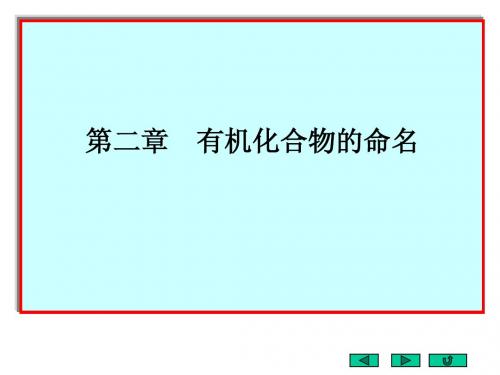
构造式
CH3(CH2)16CH3 (正) CH3(CH2)17CH3 (正) CH3(CH2)18CH3 (正) CH3(CH2)19CH3 (正) CH3(CH2)20CH3 (正) CH3(CH2)28CH3 (正) CH3(CH2)29CH3 (正) CH3(CH2)30CH3 (正) CH3(CH2)38CH3 (正) CH3(CH2)48CH3 (正) CH3(CH2)58CH3 (正) CH3(CH2)68CH3 (正) CH3(CH2)78CH3 (正) CH3(CH2)88CH3 (正) CH3(CH2)98CH3 (正) CH3(CH2)132CH3 (正)
有机化合物的命名方法概述
1、系统命名法的产生过程 IUPAC命名法 1892年——日内瓦命名法 1931年——IUC命名法 多次修订、补充…… 1979年——有机化学命名 法 CCS命名法 1932年——化学命名原则 1960年——有机化学物质 的系统命名原则 1980年——有机化学命名 原则
CCS以IUPAC基本原则为准则,结合中文特点稍有不同。
CH2CHCH2CH3 CH3
1 2 3 4
1 2
3
三级戊基或叔戊基 (tert−pentyl)
1,1−二甲基丙基 (1,1−dimethylpropyl)
-
2−甲基丁基 (2−methybutyl)
续 表2
新戊烷
CH3 CH3CCH3 CH3
CH3 CH3CCH2 CH3
新戊基(neopentyl)
2,2−二甲基丙基 (2,2−dimethylpropyl)
*1 括号中的正字可以省略; *2 在英文命名时,正用n−,异用iso−或i−,新用neo,二级用词头sec−(或s−), 三级用词头tert−(或t−)表示,后面有一短横线。
专业英语 无机化学命名

无氧酸
命名规则:hydro-词根-ic acid 举例: HCl : hydrochloric acid H2S : hydrosufuric acid HCN: hydrocyanic acid HF: hydrofluoric acid
二。2
4. Names of Bases(碱的命名):
结晶水也可写做water 如 AlCl3.6H2O: aluminum chloride 6-water AlK(SO4) 2.12H2O: aluminium potassium sulfate 12-water
二。2
6. Names of Binary Compounds (二元化合物的命名):
常见的二元化合物有卤化物,氧化物,硫 化物,氮化物,磷化物,碳化物,金属氢 化物等,命名时需要使用后缀-ide 如:fluoride, chloride, bromide, iodide, oxide ,sulfide ,nitride, phosphide, carbide,hydride; OH-的名称也是用后缀-ide:hydroxide
例:F-: fluoride ion (F:fluorine);
Cl-: chloride ion (Cl:chlorine); Br-:bromide ion (Br:bromine); I-: iodide ion (I:iodine)
* 氰根(CN-)和氢氧根(OH-)视同单原子 阴离子。
CN-:cyanide ion;OH-:hydroxide ion
元素名称 + hydroxide * 如果某元素能形成一种以上的阳离子, 则使用罗马数字来表示其所带电荷(只形 成一种阳离子的不必用).
例: NaOH: sodium hydroxide;
化学专业英语_有机化学命名

有机化合物的命名
1. Nomenclature of Hydrocarbons:(烃 ( 类命名法) 类命名法)
Prefix(数字前缀) Number Prefix(数字前缀):
总碳数≤10时 总碳数≤10时 meth甲: metheth乙: ethprop丙: propbuta丁: butapenta戊: pentahexa己: hexa庚: heptaheptaocta辛: octanona壬: nonadeca癸: deca-
总碳数>10时 总碳数>10时: >10
hen(i)dotri(a)tetra一: hen(i)-;二: do-;三: tri(a)-;四: tetra-…
10. deca11: undeca, hendeca12: dodeca13: trideca14: tetradeca15:pentadeca16: hexadeca17: heptadeca18: octadeca19: nonadeca20: eicosa21: heneicosa22: docosa23: tricosa24: tetracosa25: pentacosa26: hexacosa27: heptacosa28: octacosa29: nonacosa30: triaconta31: hentriaconta40: tetraconta50: pentaconta60: hexaconta70: heptaconta80: octaconta90: nonaconta-
CH2CH2CH3
6 5 4 3 1 2
CH2CH3
4−甲基−2−乙基−1−丙基苯 2−ethyl−4−methyl−1−propylbenzene
有机化合物英文命名规则
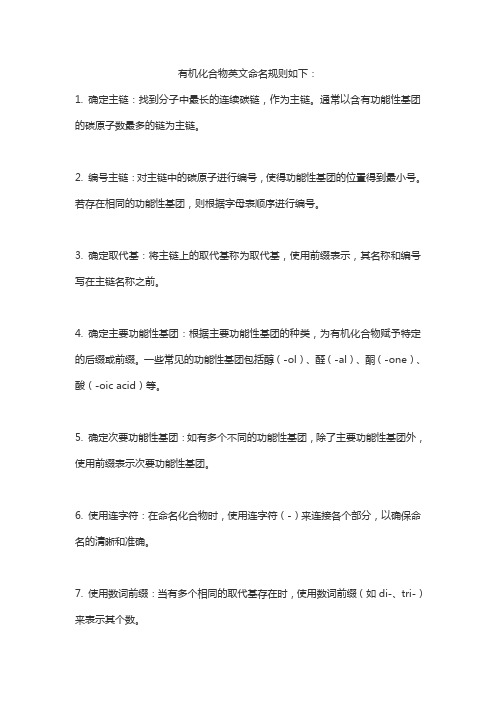
有机化合物英文命名规则如下:
1. 确定主链:找到分子中最长的连续碳链,作为主链。
通常以含有功能性基团的碳原子数最多的链为主链。
2. 编号主链:对主链中的碳原子进行编号,使得功能性基团的位置得到最小号。
若存在相同的功能性基团,则根据字母表顺序进行编号。
3. 确定取代基:将主链上的取代基称为取代基,使用前缀表示,其名称和编号写在主链名称之前。
4. 确定主要功能性基团:根据主要功能性基团的种类,为有机化合物赋予特定的后缀或前缀。
一些常见的功能性基团包括醇(-ol)、醛(-al)、酮(-one)、酸(-oic acid)等。
5. 确定次要功能性基团:如有多个不同的功能性基团,除了主要功能性基团外,使用前缀表示次要功能性基团。
6. 使用连字符:在命名化合物时,使用连字符(-)来连接各个部分,以确保命名的清晰和准确。
7. 使用数词前缀:当有多个相同的取代基存在时,使用数词前缀(如di-、tri-)来表示其个数。
需要注意的是,有机化合物的命名规则非常复杂,且涉及到多种特殊情况和命名例外。
建议在具体命名时,参考IUPAC的最新规定,或者使用专业的化学命名软件来辅助完成命名。
有机化学命名

丁基 (butyl,缩写 ) ,缩写Bu) 1−甲(基)丙基 甲 (1−methylpropyl) ) 2−甲基丙基 甲基丙基 (2−methylpropyl) )
1,1−二甲基乙基 二甲基乙基 (1,1−dimethylethyl) )
CH3CH2CHCH3
CH3CHCH2
3
2
1
异丁烷
CH3
2 1
4
3
2
1
-
CH3CH2CHCH2CH3
3
2
1
续 表2
CH3CHCH2CH2 CH3
-
4
3
2
1
异戊基( 异戊基(iso−pentyl) )
3−甲基丁基 甲基丁基 (3−methylbutyl) )
1,2−二甲基丙基 二甲基丙基 (1,2−dimethylpropyl) )
异戊烷
CH3CHCH2CH3 CH3
构造式 CH3(CH2)16CH3 (正) CH3(CH2)17CH3 (正) CH3(CH2)18CH3 (正) CH3(CH2)19CH3 (正) CH3(CH2)20CH3 (正) CH3(CH2)28CH3 (正) CH3(CH2)29CH3 (正) CH3(CH2)30CH3 (正) CH3(CH2)38CH3 (正) CH3(CH2)48CH3 (正) CH3(CH2)58CH3 (正) CH3(CH2)68CH3 (正) CH3(CH2)78CH3 (正) CH3(CH2)88CH3 (正) CH3(CH2)98CH3 (正) CH3(CH2)132CH3 (正)
CH3CHCH3 CH3
CH3CCH3 CH3
丁烷有两种异构体,每种异构体分子中都有两种不同的氢原子, 丁烷有两种异构体,每种异构体分子中都有两种不同的氢原子, 所以能产生构体,一共可产生八种戊基。 戊烷有三种异构体,一共可产生八种戊基。
化合物英文命名规则
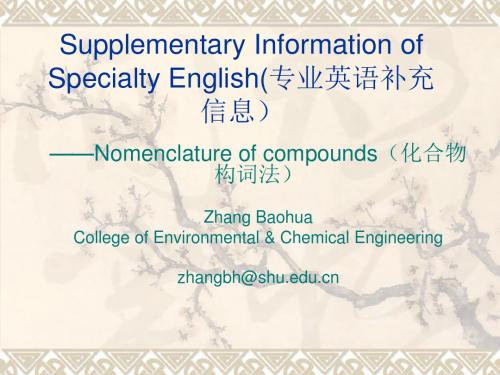
I. Nomenclature of inorganic compounds
And
“-ous”, “-ic” were also used to denote (表示) the lower and higher metallic state. 用“-ous”表示低价化合物,用“-ic” 表示高价 化合物
I. Nomenclature of inorganic compounds
5. Three elements present, such compounds are named by combining the suffix “-ate” with the name of the less electronegative of the two nonmetallic elements. And “-ite”, “-ate” are used to denote the lower and higher oxidation state of the same electronegative element. 含三种元素的化合物是通过在两种非金属元素中电负性较弱的一 种之后加后缀“-ate” 来命名的。对于电负性相同的元素,用 “-ite”表示低价元素,用“-ate” 表示高价元素 NaNO3 sodium nitrate NaNO2 sodium nitrite
cuprum
symbol
Au Fe Ag Na Sn
English Latin
gold iron Silver aurum ferrum arrgentum
autimony stibium lead mercury Plumbum hydrargyrum
Sodium Natrium tin stannum
(最新整理)化学专业英语有机化合物中英文命名一

cyclohexene
2021/7/26
27
IUPAC: International Union of Pure and Applied Chemistry
2021/7/26
2
有机化合物的命名
系统命名
IUPAC names (systematic names)
CCS命名法-中文系统命名法
CCS -Chinese Chemical Society , CCS以IUPAC基本
Trivial name: ethylene propylene butylene 如果不是端烯烃则需要给出双键在碳链中的位置
give position of C=C
2021/7/26
8
烯烃的命名(Alkene)
Names of continuous-chain alkenes(C1-C20)
(最新整理)化学专业英语有机化合物中英文命名一
2021/7/26
1
有机化合物的命名
Nomenclature of Organic Compounds
系统命名 IUPAC names (systematic names)
俗名法 trivial names (popular names)
国际纯粹化学和应用化学联合会
2021/7/26
17
支链烃的命名
Ruleiii. Give the first listed substituent a lower position number; the sum of the position numbers for all sbustituents should be as low as possible.
end of the name(去掉后缀“ane” ,加上 “yl”) methyl – nonadecyl – icosyl
化学专业英语有机化合物中英文命名二

OH OH CH2 CH2
ethylene glycol 1,2-ethanediol
CCC OH OH
propylene glycol 1,2-propanediol
OH HO-C-C-C-OH
glycerol 1,2,3-propanetriol
2、醇- Alcohols
OH
CH
H3C
CH3
2-propanol isopropanol
OH
C-C-C 2-propanol
C C-C-C
OH 2-methylpropan-2-ol
C C-C-C-C-C
OH C
4,4-dimethylpentan-2-ol
Cl-C-C-C-OH 3-c hloropropanol
2、醇- Alcohols
Trivial name (C1-C4): the name of alkyl group + alcohol
Some Functional Groups Named as Prefixes
Structure
Name
-OR
Alkoxy- *
-NH2 -N=N-
AminoAzo-
-Br
Bromo-
-Cl
Chloro-
-F
Fluoro-
-H
Hydro-
-I
Iodo-
-NO2
Nitro-
-NO
Nitroso-
* methoxy-, ethoxy-, etc., depending upon the R group
1、卤代烃-Alkyl halides
I
H3C
C H
CH3
化合物的命名
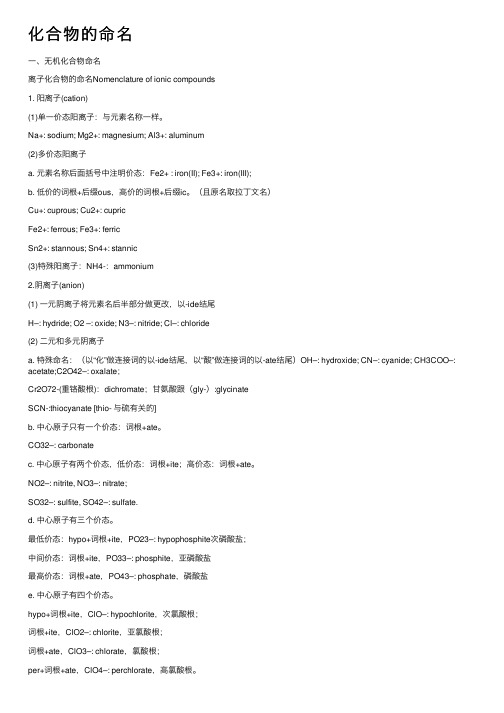
化合物的命名⼀、⽆机化合物命名离⼦化合物的命名Nomenclature of ionic compounds1. 阳离⼦(cation)(1)单⼀价态阳离⼦:与元素名称⼀样。
Na+: sodium; Mg2+: magnesium; Al3+: aluminum(2)多价态阳离⼦a. 元素名称后⾯括号中注明价态:Fe2+ : iron(II); Fe3+: iron(III);b. 低价的词根+后缀ous,⾼价的词根+后缀ic。
(且原名取拉丁⽂名)Cu+: cuprous; Cu2+: cupricFe2+: ferrous; Fe3+: ferricSn2+: stannous; Sn4+: stannic(3)特殊阳离⼦:NH4-:ammonium2.阴离⼦(anion)(1) ⼀元阴离⼦将元素名后半部分做更改,以-ide结尾H–: hydride; O2 –: oxide; N3–: nitride; Cl–: chloride(2) ⼆元和多元阴离⼦a. 特殊命名:(以“化”做连接词的以-ide结尾,以“酸”做连接词的以-ate结尾)OH–: hydroxide; CN–: cyanide; CH3COO–: acetate;C2O42–: oxalate;Cr2O72-(重铬酸根):dichromate;⽢氨酸跟(gly-):glycinateSCN-:thiocyanate [thio- 与硫有关的]b. 中⼼原⼦只有⼀个价态:词根+ate。
CO32–: carbonatec. 中⼼原⼦有两个价态,低价态:词根+ite;⾼价态:词根+ate。
NO2–: nitrite, NO3–: nitrate;SO32–: sulfite, SO42–: sulfate.d. 中⼼原⼦有三个价态。
最低价态:hypo+词根+ite,PO23–: hypophosphite次磷酸盐;中间价态:词根+ite,PO33–: phosphite,亚磷酸盐最⾼价态:词根+ate,PO43–: phosphate,磷酸盐e. 中⼼原⼦有四个价态。
有机化合物的命名规则总结

有机化合物的命名规则总结有机化合物是由碳(C)和氢(H)以及其他一些元素组成的化合物。
有机化合物的命名是为了方便人们识别不同的化合物,并准确表示它们的化学结构和性质。
在有机化学中,有一系列的命名规则被广泛接受和使用。
本文将总结主要的有机化合物命名规则,以便读者能够更好地理解和应用这些规则。
IUPAC命名规则国际纯粹与应用化学联合会(IUPAC)制定了一系列有机化合物命名的规则,以确保统一性和准确性。
以下是几个常用的IUPAC命名规则:1. 碳链命名法:IUPAC命名将有机化合物描述为由碳原子组成的链状结构。
最长的碳链通常被视为主链,并且需要用一个前缀来表示其长度(如甲烷、乙烷、丙烷等)。
在主链中,每个碳原子需要被编号,并在名称中使用。
如果有多个相同的侧链或官能团,需要使用前缀来表示其数量(如二甲基、三氯等)。
2. 取代基命名法:当有机化合物中存在其他原子或官能团时,需要使用取代基命名法。
取代基通常用作修饰主链的侧链,它们的命名通常以字母顺序表示(如甲基、乙基、氯等)。
取代基的位置应用数字表示,并在主链编号后用连字符连接(如2-甲基丙烷)。
3. 官能团命名法:官能团是有机化合物中带有特殊化学性质的基团。
官能团往往用作表示其所在化合物的前缀,以方便命名。
一些常见的官能团包括羟基(-OH)、羰基(-C=O)和氨基(-NH2)等。
4. 立体化学命名法:有机化合物中的立体化学结构对于化合物的性质和反应非常重要。
在命名时,需要考虑到立体异构体的存在。
例如,如果化合物具有手性碳原子,则应使用R和S表示法来描述其立体化学性质。
系统命名法除了IUPAC命名规则外,还存在其他几种命名规则用于特定类型的有机化合物。
1. 醇的命名法:对于醇类化合物,常用的命名法是基于其碳链长度,并将-OH基团表示为羟基。
例如,乙醇即为醇类化合物中的一种。
2. 酮的命名法:对于酮类化合物,常用的命名法是基于其碳链中酮基团(-C=O结构)的位置。
CCS命名法(中文,2017)和IUPAC命名法(英文)比较示例
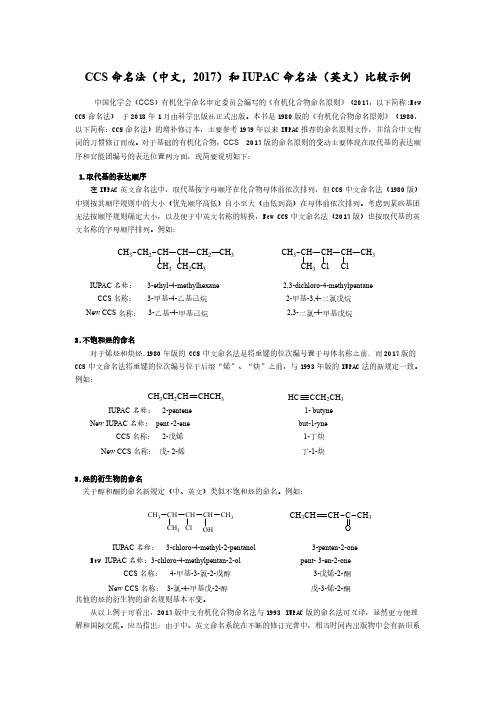
CCS 命名法(中文,2017)和IUPAC 命名法(英文)比较示例中国化学会(CCS )有机化学命名审定委员会编写的《有机化合物命名原则》(2017,以下简称:New CCS 命名法)于2018年1月由科学出版社正式出版。
本书是1980版的《有机化合物命名原则》(1980,以下简称:CCS 命名法)的增补修订本,主要参考1979年以来IUPAC 推荐的命名原则文件,并结合中文构词的习惯修订而成。
对于基础的有机化合物,CCS2017版的命名原则的变动主要体现在取代基的表达顺序和官能团编号的表达位置两方面,现简要说明如下:1.取代基的表达顺序在IUPAC 英文命名法中,取代基按字母顺序在化合物母体前依次排列,但CCS 中文命名法(1980版)中则按其顺序规则中的大小(优先顺序高低)自小至大(由低到高)在母体前依次排列。
考虑到某些基团无法按顺序规则确定大小,以及便于中英文名称的转换,New CCS 中文命名法(2017版)也按取代基的英文名称的字母顺序排列。
例如:CH 3CH 2CH CH CH 2CH 3CH 3CH 2CH 3CH 3CH CH CH CH 3CH 3ClClIUPAC 名称:3-ethyl-4-methylhexane 2,3-dichloro-4-methylpentane CCS 名称:3-甲基-4-乙基己烷2-甲基-3,4-二氯戊烷New CCS 名称:3-乙基-4-甲基己烷2,3-二氯-4-甲基戊烷2.不饱和烃的命名对于烯烃和炔烃,1980年版的CCS 中文命名法是将重键的位次编号置于母体名称之前,而2017版的CCS 中文命名法将重键的位次编号位于后缀“烯”、“炔”之前,与1993年版的IUPAC 法的新规定一致。
例如:CH 3CH 2CHCHCH 3CCH 2CH 3HCIUPAC 名称:2-pentene 1-butyneNew IUPAC 名称:pent -2-ene but-1-yne CCS 名称:2-戊烯1-丁炔New CCS 名称:戊-2-烯丁-1-炔3.烃的衍生物的命名关于醇和酮的命名新规定(中、英文)类似不饱和烃的命名。
- 1、下载文档前请自行甄别文档内容的完整性,平台不提供额外的编辑、内容补充、找答案等附加服务。
- 2、"仅部分预览"的文档,不可在线预览部分如存在完整性等问题,可反馈申请退款(可完整预览的文档不适用该条件!)。
- 3、如文档侵犯您的权益,请联系客服反馈,我们会尽快为您处理(人工客服工作时间:9:00-18:30)。
H2 SO3 Sulfurous acid H2 SO4 Sulfuric acid
HClO Hypochlorous acid HClO2 chlorous acid HClO3 chloric acid HClO4 perchloric acid
IUPAC: International Union of Pure and Applied Chemistry
The
names of linear alkanes, alkenes and alkynes(线型烷烃、烯烃、炔烃的命名): Suffix Methane(甲烷) ~ Icosane(二十烷) (C1 ~ C20 alkanes) ---ane ethene (乙烯)~ Icosene(二十烯) (give position of C=C)---ene
I. Nomenclature of inorganic compounds (无机化合物构词法)
1. Trivial name (俗名)
H2O water CaO quicklime (生石灰) NH3 ammonia (复)ammonium(单) K2CO3 potash(草木灰) CaCO3 limestone (石灰石) Hg2Cl2 Calomel (甘汞)
trivial name: ethylene(乙烯) propylene (丙烯) butylene(丁烯) acetylene (ethyne)(乙炔) ~ Icosyne(二十炔) ---yne (give position of C=C) Methane(甲烷) ethane(乙烷) propane (丙 烷) butane(丁烷) pentane(戊烷) hexane (己烷) heptane(庚烷) octane(辛烷) nonane(壬烷) decane(癸烷) undecane(十 一烷) dodecane(十二烷) tridecane(十三烷) Tetradecane(十四烷) pentadecane (十五烷) hexadecane(十六烷) heptadecane(十七烷) octadecane(十八烷) nonadecane(十九烷 ) icosane(二十烷) (C1-C20 alkanes)
potassium kalium
I. Nomenclature of inorganic compounds
4. A class of compounds in which such prefixes are seldom used is that in which the metal atom usually exhibits(展现) only one oxidation state. 当化合物中的金属元素仅有一种价态,通常很少 加前缀 ZnBr2 zinc bromide CaH2 calcium hydride Na2O sodium oxide Al2S3 aluminum sulfide
I. Nomenclature of inorganic compounds
2. If there are only two elements in the compounds(化合物), it is customary (习惯上) to name the more metallic(金属性) element first and the less metallic, or more electronegative(电负性) element second, with the suffix(后缀) “ide”. 若化合物中仅有两种元素,习惯上先命名金属性强的元素,后命名金属性弱的 元素,再加上ide作为后缀 K potassium Na sodium Ca calcium Ba barium S sulfur H hydrogen Cl chlorine Br bromine O oxygen I iodine
SnCl2 stannous chloride HNO3 nitric acid
I.
symbol
Cu Sb Pb Hg K
Nomenclature of inorganic compounds
The element symbols not from English
English
copper
Latin
Potassium nitrite Potassium nitrate
H NO2 Nitrous acid H NO3 Nitric acid
Байду номын сангаас
RbSO3 RbSO4
CsClO CsClO2 CsClO3 CsClO4
+4 +6
+1 +5 +5 +7
Rubidium sulfite Rubidium sulfate
Common substituents(常见取代基): alkyl(烷基), alkenyl(烯基), alkynyl(炔基) groups: Alkyl — omit(省略) the suffix “ane” and add “yl” to the end of the name 烷基—省略后缀“ane” ,将“yl” 加在名称之后 methyl(甲基) – nonadecyl(十九基 )– icosyl(二十 基)
I. Nomenclature of inorganic compounds
Formula
KNO2 KNO3 RbSO3 RbSO4 CsClO
Oxidation state of less electronegative atom
+3 +5 +4 +6 +1
Name of salt
Potassium nitrite Potassium nitrate Rubidium sulfite Rubidium sulfate Cesium hypochlorite
II. Nomenclature of organic compounds (有机化合物的命
名)
Nonfunctional Compounds (非功能性化合物)
A.
1. Alkane(烷烃) Alkene (olefin)(烯 烃) Alkyne (炔烃)
IUPAC names (systematic names) trivial names (popular names)
I. Nomenclature of inorganic compounds
CuI cuprous iodide FeBr2 ferrous bromide
CuI2 cupric iodide FeBr3 ferric bromide SnCl4 stannic chloride HNO2 nitrous acid
Supplementary Information of Specialty English(专业英语补充 信息)
——Nomenclature of compounds(化合物 构词法)
Zhang Baohua College of Environmental & Chemical Engineering zhangbh@
KCl potassium chloride NaBr sodium bromide BaS barium sulfide CaO calcium oxide HI hydrogen iodide
I. Nomenclature of inorganic compounds
3. For compounds containing still only two elements but more than two atoms(原子), the prefixes (前缀)“mono-”, “di-”, “tri-”, etc. become necessary. 对于仅含两种元素、但多于两个原子的化合物,加 “mono-”, “di-”, “tri-”等前缀很有必要 (1)mono-, (2)di-, (3)tri-, (4)tetra-, (5)penta-, (6)hex-, (7)hept-, (8)octaCl2O di-chlorine monoxide ClO chlorine monoxide ClO2 chlorine dioxide ClO3 chlorine trioxide Cl2O7 di-chlorine heptoxide ClO4 chlorine tetroxide
I. Nomenclature of inorganic compounds
When there are more than two oxidation states of the electronegative element, prefix used. The prefix “hypo-” meaning “below”, is used in the name of the lowest oxidation state. The prefix “per-” meaning “highest”, is used when it is in the highest oxidation state. 当电负性较低的元素有超过两种价态时,就使用前缀。 前缀“hypo-” 表示“低于”,用于低价态之前;前 缀“per-” 表示“高于”,用于高价态之前
cuprum
symbol
Au Fe Ag Na Sn
English Latin
gold iron Silver aurum ferrum arrgentum
autimony stibium lead mercury Plumbum hydrargyrum
